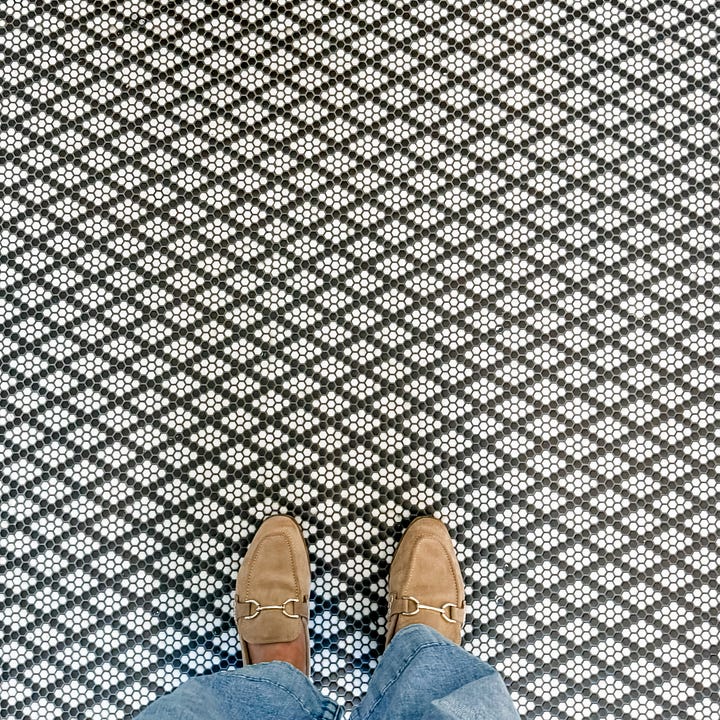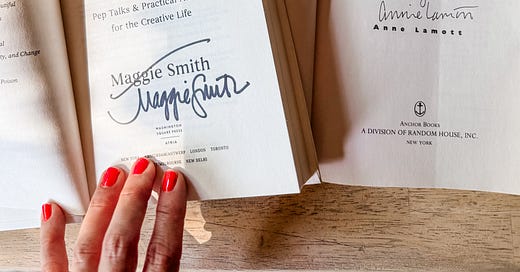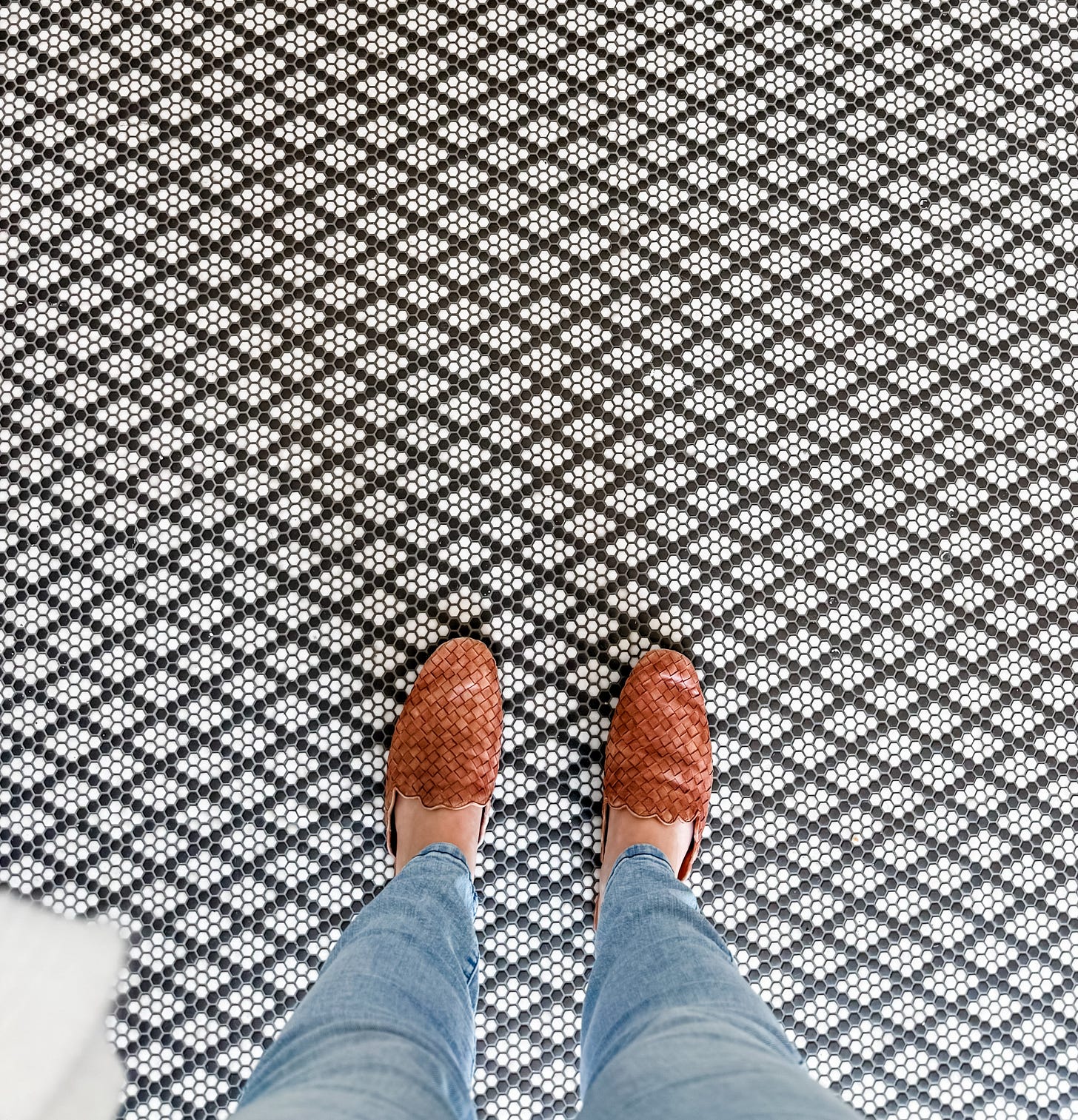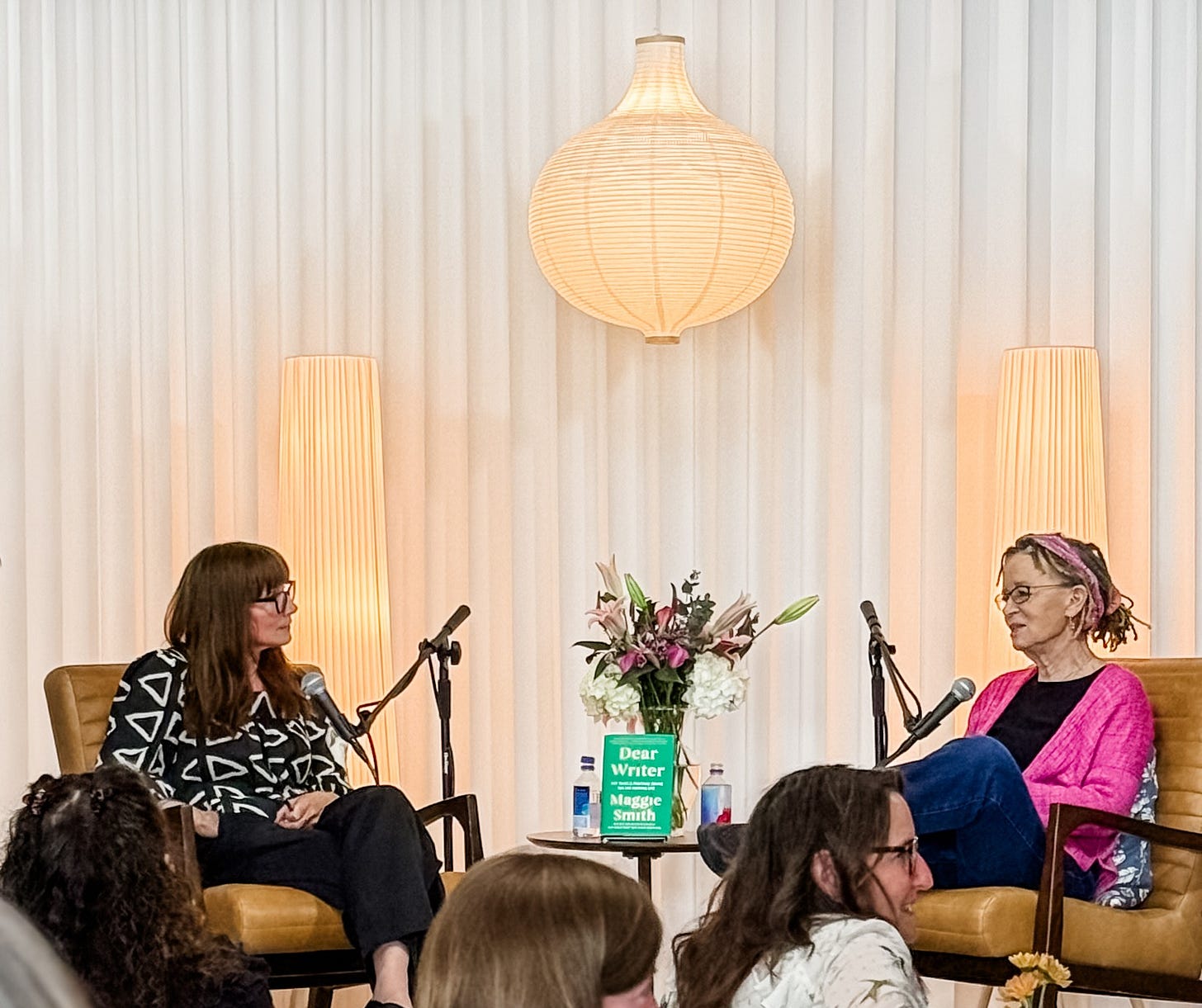"Writing Gives You You." —Anne Lamott
Writerly Insights and What Met Me in the Room with Maggie Smith and Anne Lamott
There are rooms we long to enter. Spaces we yearn to belong to. People we hope to meet—creative idols who speak aloud the truths and dreams we’ve only dared to whisper. From the shadows, we peer in and see evidence of things we hope for—right there in the light. Markers of who we want to become and where we want to be.
Some of us spend years wondering if we belong in the room or if we can become who we want to be. If you’re like me, you might have disqualified yourself, or perhaps others have shut the door on you. Many of us live with a longing—a persistent and insistent soul-level calling—that keeps trying to move us forward while other forces (internal and external) try to hit the brakes.
In this regard, I’ve made a vow to myself. I will go in the direction of the pull and calling I feel in my life. I will say “yes” to the opportunities that appear before me that align with what makes me come alive and feel more like myself.
So, when I come across a writing workshop in San Francisco with two of my writing heroes, Maggie Smith and Anne Lamott, I say an easy “yes.”
Yes, I want to be in the room with them! I want to sit in a room with women who embody creative magic—mythical literary unicorns whose books have lived on my shelves for years—if only to prove to myself they are real.1 One of the greatest discoveries I’ve made in stepping into rooms with creative “celebrities” is realizing that they are, in fact, human—just like me. This gives me hope. This lessens the gap between fantasy and reality. If they can do it, so can I.
Right?
But after I purchase my event ticket, the interrupting thoughts rush in, prompted by the questioning of the Inner Critic herself. They ride along in the passenger seat as I drive north up the 101 towards the city.
What are you even doing? Who do you think you are? Do you really believe you belong at an event like this? You don’t belong in the room. You’re never going to be a ‘real’ writer. You’re a nobody. You’re such an impostor, a wannabe.
But the questions and thoughts trail off as their mission to silence, shame, and stop me fails. I’m going anyway. The opportunity is in crystal clear alignment with who I am, what I do, and what makes me come alive. I want to be near and learn from these brilliant women. My sponge-like self wants to absorb whatever wisdom they are willing to offer. And I want to meet whatever is meant to meet me there. Because I’m not just going to fan-girl and meet two of my favorite writers.
I’m going to meet myself.
I walk up to the industrial building, and my suspicions are confirmed. I’ve been here before. I walk into the room on the second floor. It’s spacious yet intimate, adorned with flowers, and, yes, familiar. Almost one year ago, I sat in the very same room with a small number of creatives and another creative hero: Amiee McNee (author of We Need You Art and creative behind the Instagram account @inspiredtowrite).


And so, I walk through the tunnel of flowers feeling a bit like a bride—or maybe more like a queen, coronating myself as a writer once again.
I find a seat in the fourth row, and I settle in with ease, a newfound relief in not being performative or preoccupied with perception, fully present.
The evening starts with Maggie Smith taking the stage, effortlessly moving right into the writing workshop. What a gift to be guided through a series of writing prompts by Maggie Smith! Her presence, poise, passion, and professionalism as an expert in the craft radiate throughout the room. The pace is quick—five minutes or less per prompt—but somehow I didn’t feel like I was trying to drink from a fire hydrant, the way I often have in other workshops
Somehow, I’m floating along a river of creative ideas.
By the end of the session, the room collectively marvels at what can happen in just five minutes. The joy isn’t in crafting something polished or stringing together perfect words, but in witnessing what emerges when we simply catch whatever comes. Not everything we put down in ink will become something lasting. But in sifting through the sands of our words, we might uncover something that stands out and shimmers, like a piece of sea glass catching light.2
The evening shifts from workshop to conversation as the legendary Anne Lamott casually strolls into the room, wearing a bright pink cardigan, and personally greets attendees. I’d seen Anne Lamott speak once before, during a live interview on her Somehow: Thoughts on Love book tour—but until this evening, I’d never met her personally.
Now, Anne Lamott herself appears right in front of me, extends her hand to shake mine, and warmly greets me. She shares her delight in having real people in the room for this event hosted by A Writing Room (which mainly shares a virtual space). And onward she continues down the row, offering handshakes and hellos.
During the break, Anne and Maggie share a brief private conversation on stage while the rest of us chat. And then, the question and conversation portion of the evening begins.
I love what unfolds next—and it might surprise you.
I witness two women, both accomplished in their crafts and wildly successful as authors, share completely different approaches to writing. Now, of course, some universal agreements about writing emerge, but it was the differences I loved.
You see, there’s this unspoken expectation—this hidden desire—that surfaces when we step into rooms like these. We want to be given the answer. Handed the formula. Told the secret to success. Show us how the magic trick works. Sometimes, that’s the very reason we show up—as if being with people like Anne and Maggie, who seem to have figured it out, might finally let us in on it.
But of course, that’s not what happens.
Wisdom is shared, yes, but there is no one-size-fits-all answer. No magic. No secret or scientific formula. Other than maybe this: Just write. It’s as simple and hard as that.3
We have to find our individual ways as writers and creatives. No one else can do it for us. Sure, others can help guide us, some might open doors, and others have certainly cleared paths. But ultimately, we are responsible for ourselves and our writing.4
No one else can know us like we know ourselves.5
No one else can tell us what is going to work for us.6
No one else is going to show up for us.
No one else is going to write for us.
No one else is going to put in the work for us.
We have to. We get to.
Anne and Maggie embody this truth in their own ways. Anne explains that she writes daily—she has to. She knows how she works. On the other hand, Maggie calls herself a “pantser”—the thing so many of us writers are told not to be. I personally admire how rebellious this feels and how Maggie unapologetically owns not having a daily writing habit. She says she’s “ritual-less” and rarely writes at her desk, claiming, “My office is the world.”
Although their writing approaches are tailored to what works for them, a shared thread appears:
They pay attention. They notice. They listen. They write it down.
They capture interesting observations that float into their minds (Anne likens them to goldfish), and they put them down on the page. Maggie mentions an example of gazing at a cloud in the sky, the metaphors that appear in her mind, and the weird questions she asks in response. Writing starts with paying attention and putting ideas in ink, which, of course, echoes Mary Oliver’s instructions for living a life:
“Pay attention. Be astonished. Tell about it.”
When asked about what to then do with such inklings of ideas and outlining, Anne confesses that her writing has come to follow a repeatable structure that functions as her version of an outline, but that’s as far as she goes. Maggie shares that she doesn’t outline in the typical sense, describing her process as similar to collecting and collaging.
The conversation turns to dealing with the Inner Critic and Inner Resistance. As life-giving as writing is for me, sometimes it’s really hard to keep writing—or finish writing—because my Inner Critic is loud, the Inner Resistance is strong, and the resulting tension can be paralyzing. Anne, in particular, has a lot to say about this, which I appreciate and scribble down in my notebook. I draw a star next to this line:
“If I’m going to be [writing], I may as well cooperate.”
— Anne Lamott
I quietly chuckle in resonance and make a mental note to transfer her words to a sticky note on my desk.
The two move into a conversation about their why.
“Writing is the way I stay in touch with myself.”
—Maggie Smith
Maggie describes the practice of writing as a type of communion with herself. My spirit nods in agreement. Anne shares that she writes because she feels a pull to and calls it spiritual. More nods. She adds that she writes because she’s good at it; it feeds her soul; she feels safe and at home in the written word.
Anne turns, addressing those of us in the room, and says,
“Writing gives you you.”
I need no more reason than that.
Maybe that is all the reason you need, too.
In that moment—barely perceptible to anyone else, and almost even to me—I felt a thin inner layer shed: the need to be understood, the need to explain or defend, the longing for others—especially those who aren’t writers—to affirm why I write, how I work, and who I am.
But in that room, in that moment, the layer falls away.
Anne and Maggie (and other writers) share and understand this reality of living as a writer in the world—and not everyone else will. And maybe… that’s okay. Maybe their lack of understanding—or their lack of approval—isn’t any of my business. My business is simply being me. And being me means calling myself a writer. It means embracing writing and all the weird nuances and idiosyncrasies that come with it for me and letting all other hindrances go.
If you’d asked me ten years ago about my writing, I probably would’ve said I wanted to write like Mary Oliver, Madeleine L’Engle, or Ann Voskamp. And now, you might assume I want to write like Maggie Smith or Anne Lamott. But the truth is—I don’t. And that’s good news! I can’t write like them because I’m not them. I’ve shared this before, and I’ll share it again.
I want to write like me—like Kristin Vanderlip.
I want to continue to meet myself. I want to know what it means to be me and write like me. I want to hear the sound of my voice and see it play out on the page—or, as Anne might say, I want to sing my own unique bird song.
But the journey isn’t easy, and I appreciate how Anne names the fear and still urges us forward as the evening draws to a close. I tuck these words of hers into my notebook:
“You’ve got to get into the water.”
It’s cold. It’s scary. But you have to step off the ladder, let go of the edge, and trust that the water—the process—will hold you. As I listen, I feel myself holding on, scared to let go. But with Anne’s encouragement, maybe I can.
So, you want to write?
“Get it down. Get it down. Make it better.”
—Anne Lamott
I recommit to the journey and renew the vows I’ve made to myself.
I stepped into the room, overjoyed at the chance to meet two of my writing heroes, and I leave with the joy of having met myself again, feeling more full than when I arrived. This is the miracle of rooms and moments like these.
Not that they hand us answers, but that they can remind us of who we are and to keep showing up.
Not to become someone else, but to become more fully who we already are. To keep becoming. Keep going. Keep writing.
*And, to not journey alone.7
With so much gratitude to Anne Lamott and Maggie Smith—for the wisdom you shared, the room you created, and the courage you stirred in me,
—Kristin (with an -in)
P.S. Go meet your heroes. You just might catch glimpses of yourself.
Prompts for Reflection
If you feel inspired to reflect on your own creative journey, here are a few questions to consider:
Who are the creative voices that have shaped or sustained you?
Have you ever felt like an outsider looking in—peering into a “room” where you hope to belong?
What might it look like to claim your own rhythm, your own way of creating?
What’s one small way you can say “yes” to your creative calling this week?

I hope you all know that searching for sea glass is one of my favorite things ever.
Who said it first? Stephen King? Charles Bukowski?
As I write this I wonder, Are we also responsible to some degree for each other? But that question is for another time.
And often we start here. How many of us can say we know our truest selves? I might guess not many of us. Writing and creativity offer us the gift of discovering and knowing ourselves.
This is what I love about coaching—coaching is not telling you what to do, it’s helping you tap into yourself, listen to yourself, and do this very work.
Anne Lamott offers A Writing Room. I offer Pen & Mend and other writing/journaling resources. There are so many beautiful ways to be in community with other writers and creatives and find your believing mirrors.









This was a beautiful encouraging piece to read. Thank you for sharing your journey. I’m new to writing publicly. In my mid 60s, I jumped into this to express my own creative process. I’ve journaled most of my life to process my feelings. Writing is so helpful for that. I’m so glad I came across your Substack. I so want to improve this craft/gift and these words were just what I needed
Loved reading this! Thanks for sharing :)